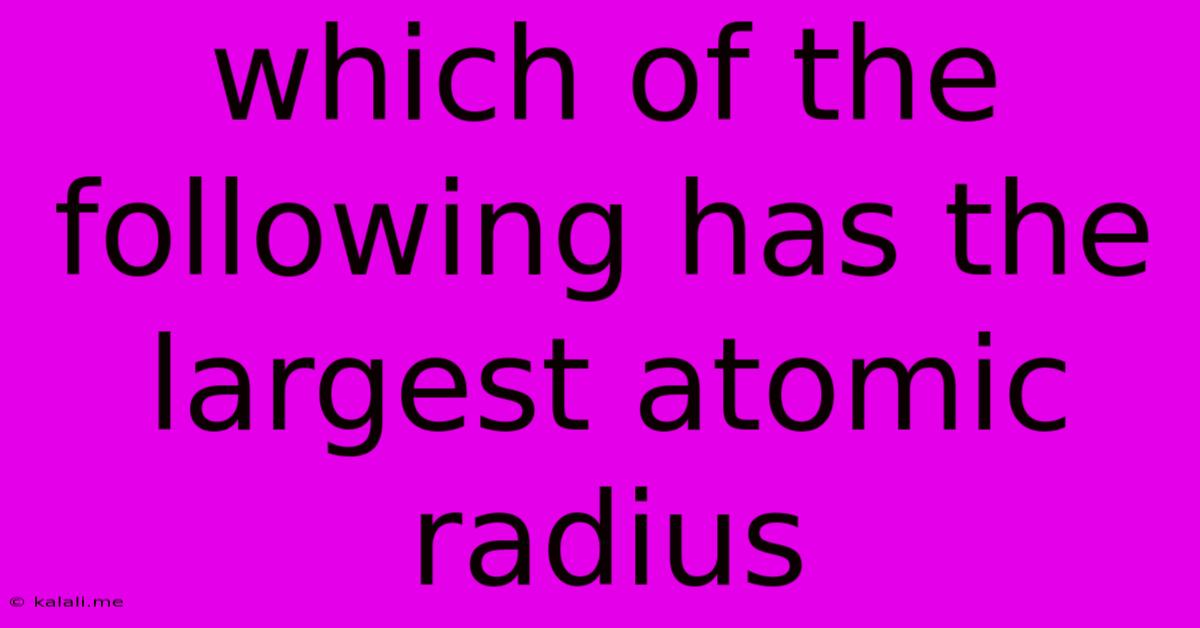Which Of The Following Has The Largest Atomic Radius
Kalali
Jun 13, 2025 · 3 min read

Table of Contents
Which of the Following Has the Largest Atomic Radius? Understanding Atomic Size Trends
Determining which element possesses the largest atomic radius from a given set requires understanding the periodic trends that govern atomic size. This article will explore these trends and provide you with the knowledge to confidently answer this type of question. We'll look at factors like electron shielding, effective nuclear charge, and the impact of electron shells.
Factors Affecting Atomic Radius
The atomic radius, a measure of the size of an atom, isn't a fixed value. It's influenced by several key factors:
-
Number of electron shells: As you move down a group (column) in the periodic table, atoms gain additional electron shells. Each shell is further from the nucleus, resulting in a larger atomic radius. This is the most significant factor.
-
Effective nuclear charge: The effective nuclear charge is the net positive charge experienced by an electron in a multi-electron atom. It's the difference between the actual nuclear charge and the shielding effect of inner electrons. A higher effective nuclear charge pulls electrons closer to the nucleus, reducing the atomic radius.
-
Shielding effect: Inner electrons shield outer electrons from the full positive charge of the nucleus. More inner electrons lead to greater shielding, reducing the effective nuclear charge and allowing outer electrons to occupy a larger space.
Periodic Trends and Atomic Radius
Understanding the periodic trends is crucial for predicting atomic radii:
-
Across a period (row): Atomic radius generally decreases as you move from left to right across a period. While another electron shell is not added, the increasing nuclear charge pulls the electrons closer to the nucleus, thus decreasing the atomic radius.
-
Down a group (column): Atomic radius generally increases as you move down a group. The addition of new electron shells significantly outweighs the increase in nuclear charge, leading to a larger atomic radius.
Example: Comparing Atomic Radii
Let's consider a hypothetical example: Which has a larger atomic radius, Sodium (Na) or Chlorine (Cl)?
Sodium (Na) is in Group 1 and Chlorine (Cl) is in Group 17, both in Period 3. Because atomic radius decreases across a period, Sodium will have a larger atomic radius than Chlorine. Sodium's single valence electron is shielded by the inner electrons and experiences a weaker effective nuclear charge compared to Chlorine's multiple valence electrons.
To determine the largest atomic radius from a set of elements, identify the element with the:
- Highest principal quantum number (n). This indicates the greatest number of electron shells.
- Lowest effective nuclear charge, which means more shielding of the outer electrons.
Conclusion
Predicting the element with the largest atomic radius involves considering the interplay of electron shells, effective nuclear charge, and the shielding effect. By understanding these periodic trends and applying them systematically, you can accurately compare the atomic radii of different elements and confidently answer questions like "Which of the following has the largest atomic radius?" Remember to consult a periodic table to determine the position of the elements in question. The periodic table itself is an invaluable tool in understanding these trends.
Latest Posts
Latest Posts
-
Determinant Of A Lower Triangular Matrix
Jun 13, 2025
-
Which Of The Following Statements Is True Of Human Capital
Jun 13, 2025
-
Sum Of Two Irrational Numbers Is Always Irrational
Jun 13, 2025
-
Cape Fear Community College Acceptance Rate
Jun 13, 2025
-
Which Of The Following Is Not A Vital Sign
Jun 13, 2025
Related Post
Thank you for visiting our website which covers about Which Of The Following Has The Largest Atomic Radius . We hope the information provided has been useful to you. Feel free to contact us if you have any questions or need further assistance. See you next time and don't miss to bookmark.